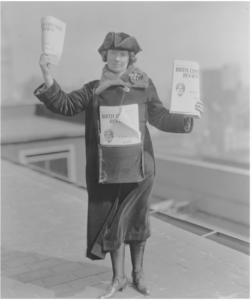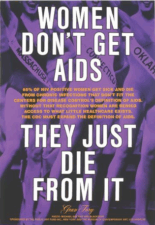“Shall we break this Law” stared me in the face from the cover of the “Review”. “Law” indeed! That was no law, but a tyranny forced upon voteless women buy a “morality” fanatic, Anthony Comstock, in 1887, and so far its constitutionality had not been challenged.”[i]
Actresses for long have been neglected from the larger meta-narrative of women’s labor history that fueled the urge in me to unearth more about their lives and socio-political engagement. While researching in the summer of 2019, at the Women’s Library of London School of Economics, I stumbled upon Kitty Marion’s type-written autobiography. At that time, I was relatively familiar with her body of work in suffrage movement and I knew she was a music hall actress and a singer. However, I had never come across historiography that reflected on her being an actress and the incessant hours she spent sharpening her creative labor. She strived relentlessly for several causes including the protection of other actresses from assault at workplace.
Historians like Dr. Fern Riddell have written dexterously about her contribution as a radical feminist and suffragette.[ii] However, my research encapsulates Marion primarily as a performer who through her creative labour altered perceptions regarding sexual behavior. I posit her in the realm of theatre to closely analyze her performativity in terms of labour and socio-political engagement. By the virtue of being an actress she was very much exposed to the ‘gaze’ in the public domain. Her political career was drawn from her being on stage in the public eye which set her apart from other political workers and suffragettes. Her creative labour that was channeled through her performance, ultimately ensued aspects of radicalism. The libertine culture of theatre gave her exposure to a whole body of knowledge regarding sexual behavior that wasn’t given anywhere else. She channeled this knowledge in taking up a prominent role the in the American birth control movement also helping other actresses in case of sexual harassment at workplace. Having faced an abusive childhood, she says that it was the stage that gave her freedom for the first time, therefore she wasn’t just a radical suffragette but a ‘radical actress-suffragette’. My project focusses on the role of performativity and stage that was embodied by Kitty Marion whenever we analyze her corporeal identity on stage and her radical political engagement otherwise.
Marion was greatly inspired by Margaret Sanger’s work on birth control in the United States right after the First World War. Being of German origin she was skeptical of taking up activism, but it was the sheer gravity of the cause that made her one of the pioneers of birth-control. Marion often utilized her creative labor of being an excellent singer and channeled it to the cause of birth-control and suffrage. Historian Viv Gardner highlights that Marion’s strong and resonant voice fuelled a change in the political climate both in England and United States.[iii]However, being a music-hall and a theatre actress at that point in time, she often felt that her contribution at the American Birth Control League as compared to other women in the movement would not be of substantial nature, as at that time the profession of actresses invited a lot of disdain amidst the overarching presence of strict moral codes. Other stalwarts who were a part of the movement were Miss Elizabeth Stuyvesant, suffragist and social reformer and Miss Anna Lifshitz who was a stenographer. Marion went on to become one of the prominent women who brought out the “Birth Control Review”. Her picture of selling the review is a very popular one!
Kitty Marion was inspired by Margaret Sanger’s forceful and determined way of putting forth the argument of birth control. On reading Sanger’s article on birth control; Marion was deeply moved and thought to herself that, “this is one of the laws that is better honored by breach rather than observance.” [iv] Marion took to the forefront of the birth control movement when Margaret Sanger was serving her time in Queens County Jail. She was of the view that a real change in the dominant social thought could be achieved through the “masses”. Marion says that it was often surprising why some Birth Control ‘enthusiasts’ did not sell the Review on the streets to bring the question before the “masses” whom it principally concerned. On the day of Margaret Sanger’s release, Marion being a talented singer tried to utilize her creative labor to inspire the crowds and sang Women’s Marseillaise- “Arise ye daughters of a Land that vaunts its liberty!”
Kitty Marion was relatively popular in the American theatrical arena as well. She reflects in her autobiography how the management of Broadway Theatre where she felt at ‘home’ was sympathetic to her cause. Marion was nonetheless subjected to harsh remarks like, “You ought to be arrested!”, “You ought to be jailed!”, “You ought to be hanged!”, “You ought to be shot!”[v] Being actively involved in the cause of suffrage previously and being an actress, this was not new to Marion!
The birth control movement in America collided on the question of English and American moral codes. According to the popular perception of American women, their men treated women better than English men. Therefore, the aggressiveness of birth control movement in America was futile. However, Marion, having closely observed that condition of women in both the countries points out in her autobiography that the transnational cause of women and birth control remains the same in both the countries when it tackles the concern of bad and indifferent treatment meted out towards women.
The Birth Control Review was taken over by the New York Women’s Publishing Company that consisted of women and men from all over the America, financially fostering and enthusiastically conforming to the cause of birth control. The street selling of the Review became the unique selling point as it directly intersected with moral codes and adjectives women were subjected to, like; undignified, unscientific, unladylike and so on. Marion reflects on how with the help of Margaret Sanger, Married Love by Dr. Marie C. Stopes (who also founded Britain’s first birth control clinic in 1921, Holloway, London) was first published by Dr. William J. Robinson, physician, sexologist and birth-control advocate in America. Marion’s constant persistence in selling of the Birth Control Review on the streets in turn popularized Married Love in America. This eventually helped a lot of couples who were at the brink of ending their marriage.
While talking about actresses Marion says, “these women were rule-breakers, social transgressors, women who refused to stay in the place the patriarchal society had carved out for them”. Specifically in music halls these feisty women refused to conform to patriarchal mores. Channeling their sexuality into their creative labour the kind of sexual freedom the embodied was an anomaly in an overarching and omnipresent Victorian environment. Actresses of the music hall had to embody radicalism as a part of their survival strategy in a male dominated arena as they were often subjected to the public gaze. They challenged class boundaries and sexual ‘morality’ and ‘respectability’ from the very onset and their creative labour empowered them to do so. Hence, Kitty Marion was already deeply rooted in the cause of women and concerns of sexual behavior due to her profession that also enabled her as an activist in several ways. As a result, she became one of the pioneers of the birth control movement.
Well, if you have the courage to stand there and sell, I’ll have the courage to buy it.”[vi]
Twisha Singh is a PhD research scholar at the Department of History and Classical Studies, McGill University, Montreal, Canada. Her project analyses political engagement, socio-economic identity, occupational mobility, and creative labor of women working as stage actresses in Calcutta and London. Her aim is to study the cross-cultural and transnational ties between English and Indian (Bengali) actresses during the late 18th and early 19th centuries, along with analyzing the urban history of both the cities. She is the Vice-Chair of the Graduate Student’s Committee at the Canadian Historical Association and the Editor of a peer-reviewed Journal called HARF-A Journal of South-Asian Studies. Her research has been awarded the prestigious Wolfe Graduate Fellowship (Canada) and Youth Excellence Award by the International Human Rights Organization (India).
Image: Kitty Marion selling the Birth Control Review in New York
Source: The British Library
[i] Kitty Marion, Autobiography, Women’s Library, London School of Economics
[ii] Fern Riddell, Death in Ten Minutes: The Forgotten Life of Radical Suffragette Kitty Marion (London, 2018)[ii] Christine Woodsworth, “The Company She Kept: The Radical Activism of Kitty Marion from Piccadilly Circus to Times Square”, Theatre History Studies (2012), pp. 80-92
[iii] Viv Gardner, Diane Atkinson, “Kitty Marion: Actor and Activist”, (Manchester, 2019)
[iv] ibid
[v] Kitty Marion, Autobiography, Women’s Library, London School of Economics


